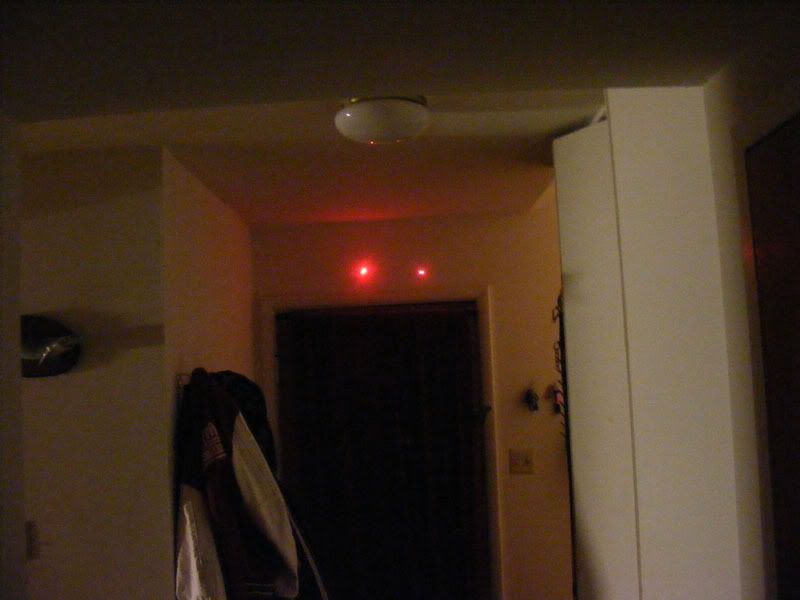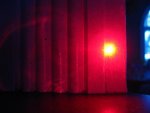Welcome to Laser Pointer Forums - discuss green laser pointers, blue laser pointers, and all types of lasers
Buy Site Supporter Role (remove some ads) | LPF Donations
Links below open in new window
FrozenGate by Avery
Navigation
Install the app
How to install the app on iOS
Follow along with the video below to see how to install our site as a web app on your home screen.
Note: This feature may not be available in some browsers.
More options

You are using an out of date browser. It may not display this or other websites correctly.
You should upgrade or use an alternative browser.
You should upgrade or use an alternative browser.
635nm vs. 650nm
- Thread starter Dingers
- Start date


Razako
0
- Joined
- Mar 17, 2006
- Messages
- 4,301
- Points
- 113
The best way to see the difference is to point a 5mw 650nm and a 5mw 635nm at a white wall and compare the two dots. The 635nm will look visibly brighter and will also be more vibrant/eye catching.
Here is a pic from the reviews section.

Here is a pic from the reviews section.

- Joined
- Jun 13, 2007
- Messages
- 5,410
- Points
- 113
From close up, you can barely tell the difference between the two colors. Over a distance is where you can tell the biggest difference. 635nm goes surprisingly far considering it is 5mW of red. You also can tell that 635nm is orangish from a distance, but it is still more red than anything. In fact, you can even barely see the beam from a 635nm at night.
If you need some pictures I can take some. I attached a picture of shining a 5mW 635nm module at a wallish thing.
If you need some pictures I can take some. I attached a picture of shining a 5mW 635nm module at a wallish thing.
Attachments
andy_con
0
- Joined
- May 24, 2007
- Messages
- 3,394
- Points
- 0
with ratios -
650nm to 532nm its 4:1
635nm to 532nm its 2:1
so a fair bit brighter
650nm to 532nm its 4:1
635nm to 532nm its 2:1
so a fair bit brighter
andy_con
0
- Joined
- May 24, 2007
- Messages
- 3,394
- Points
- 0
LOL not sure probably something like 10:1
405nm is very very dark
405nm is very very dark
Benm
0
- Joined
- Aug 16, 2007
- Messages
- 7,896
- Points
- 113
If you want visibility ratios for various colors, why not look at the CIE data for the luminosity function:
http://www.cvrl.org/database/text/cmfs/ciexyz31.htm , in http://www.cvrl.org/database/data/cmfs/ciexyz31.txt the middle column gives relative visibility with 555 nm = 1.
532nm is almost as visible as it gets with about 0.9, 635 is at 0.32, and 660 at about 0.06.
I quote the 660 nm figure since that is what most dvd diode based pointers actually produce, despite claiming 650 nm. So 660 to 532 would be a factor of 15, 660 to 635 about 5, and 635 to 532 about 3.
For blu ray there is a problem with this dataset as it has been proved to be pretty far off reality for lower wavelenghts. If you use the stockman correction the ratio between 405 and 532 should be in the order of 200 times.
With the laser dot this is obviously much less apparent since it makes most materials flouresce and hence appears much brighter.
http://www.cvrl.org/database/text/cmfs/ciexyz31.htm , in http://www.cvrl.org/database/data/cmfs/ciexyz31.txt the middle column gives relative visibility with 555 nm = 1.
532nm is almost as visible as it gets with about 0.9, 635 is at 0.32, and 660 at about 0.06.
I quote the 660 nm figure since that is what most dvd diode based pointers actually produce, despite claiming 650 nm. So 660 to 532 would be a factor of 15, 660 to 635 about 5, and 635 to 532 about 3.
For blu ray there is a problem with this dataset as it has been proved to be pretty far off reality for lower wavelenghts. If you use the stockman correction the ratio between 405 and 532 should be in the order of 200 times.
With the laser dot this is obviously much less apparent since it makes most materials flouresce and hence appears much brighter.
Zom-B
0
- Joined
- Mar 25, 2008
- Messages
- 895
- Points
- 28
Hey this thread is a double post. My answer including CIE is already in this thread: http://www.laserpointerforums.com/forums/YaBB.pl?num=1210508946
Benm
0
- Joined
- Aug 16, 2007
- Messages
- 7,896
- Points
- 113
Didnt see the other answer about the CIE function yet, but i guess it all boils down to the same anyways.
650/660 nm diodes have a real world application, dvd players and writers, 635 nm do not, apart from laser pointers which is far from a big market.
Also producing lower wavelength diodes is more difficult (worse yields), which is probably why they chose 660 nm for the dvd - at 635 more information would fit on a disc.
650/660 nm diodes have a real world application, dvd players and writers, 635 nm do not, apart from laser pointers which is far from a big market.
Also producing lower wavelength diodes is more difficult (worse yields), which is probably why they chose 660 nm for the dvd - at 635 more information would fit on a disc.
phenol
0
- Joined
- Oct 30, 2007
- Messages
- 533
- Points
- 18
here are some 635nm high power LD cost examples :Ace82 said:One of my first lasers was 635nm and I always thought of it as 'red-orange'. I paid $119 for a 5mW pen back in 1994. Is there some reason why 650nm has dominated over 635? Can you get high powered 635nm diodes (for reasonable costs)?
60mW single mode - EUR320
100mW multimode, 9mm - EUR154
150mW multimode, TO3 - EUR180
300mW------------------- - EUR370
500mW------------------- - EUR444



